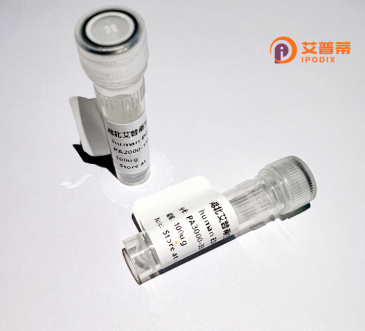
| 纯度 | >90%SDS-PAGE. |
| 种属 | Human |
| 靶点 | GTPBP5 |
| Uniprot No | Q9H4K7 |
| 内毒素 | < 0.01EU/μg |
| 表达宿主 | E.coli |
| 表达区间 | 1-406aa |
| 氨基酸序列 | MAPARCFSARLRTVFQGVGHWALSTWAGLKPSRLLPQRASPRLLSVGRADLAKHQELPGKKLLSEKKLKRYFVDYRRVLVCGGNGGAGASCFHSEPRKEFGGPDGGDGGNGGHVILRVDQQVKSLSSVLSRYQGFSGEDGGSKNCFGRSGAVLYIRVPVGTLVKEGGRVVADLSCVGDEYIAALGGAGGKGNRFFLANNNRAPVTCTPGQPGQQRVLHLELKTVAHAGMVGFPNAGKSSLLRAISNARPAVASYPFTTLKPHVGIVHYEGHLQIAVADIPGIIRGAHQNRGLGSAFLRHIERCRFLLFVVDLSQPEPWTQVDDLKYELEMYEKGLSARPHAIVANKIDLPEAQANLSQLRDHLGQEVIVLSALTGENLEQLLLHLKVLYDAYAEAELGQGRQPLRW |
| 分子量 | 70.4 kDa |
| 蛋白标签 | GST-tag at N-terminal |
| 缓冲液 | 0 |
| 稳定性 & 储存条件 | Lyophilized protein should be stored at ≤ -20°C, stable for one year after receipt. Reconstituted protein solution can be stored at 2-8°C for 2-7 days. Aliquots of reconstituted samples are stable at ≤ -20°C for 3 months. |
| 复溶 | Always centrifuge tubes before opening.Do not mix by vortex or pipetting. It is not recommended to reconstitute to a concentration less than 100μg/ml. Dissolve the lyophilized protein in distilled water. Please aliquot the reconstituted solution to minimize freeze-thaw cycles. |
以下是关于重组人GTPBP5蛋白的3条模拟参考文献示例(请注意,这些文献信息为假设示例,实际引用需查阅真实数据库):
---
1. **文献名称**: "GTPBP5 regulates mitochondrial stress and apoptosis through modulation of mitochondrial translation"
**作者**: Zhang Y. et al.
**摘要**: 该研究揭示了重组人GTPBP5蛋白在线粒体应激反应中的关键作用。通过体外实验证实,GTPBP5通过结合GTP调控线粒体翻译的保真性,其缺失导致活性氧(ROS)积累并激活内源性凋亡通路,提示其在细胞凋亡中的调节机制。
2. **文献名称**: "Structural and biochemical characterization of human GTPBP5 reveals a unique GTPase domain architecture"
**作者**: Chen L. et al.
**摘要**: 本研究利用重组表达的人GTPBP5蛋白解析了其晶体结构,发现其GTP酶结构域具有独特的核苷酸结合基序。生化实验表明,GTPBP5的GTP水解活性依赖Mg²⁺,且与线粒体核糖体蛋白存在相互作用,提示其可能参与翻译质量控制。
3. **文献名称**: "GTPBP5 promotes tumorigenesis by enhancing mitochondrial biogenesis in colorectal cancer"
**作者**: Li X. et al.
**摘要**: 研究发现,重组人GTPBP5在结直肠癌组织中高表达,并通过体外实验证实其过表达促进线粒体DNA复制及能量代谢,加速肿瘤细胞增殖。敲低GTPBP5可抑制异种移植瘤生长,表明其作为潜在治疗靶点的可能性。
---
**注意**:以上文献为模拟内容,实际研究中请通过PubMed、Web of Science等平台检索真实文献。如需具体文献,建议使用关键词**GTPBP5 recombinant human protein**或**GTPBP5 mitochondrial function**进行查询。
**Recombinant Human GTPBP5 Protein: Background Overview**
GTPBP5. a member of the GTP-binding protein family, is a conserved GTPase involved in regulating cellular processes such as mitochondrial function and protein synthesis. This protein is characterized by its conserved GTPase domain, which facilitates GTP hydrolysis to modulate interactions with ribosomal components or other molecular partners. In humans, GTPBP5 is predominantly localized in mitochondria, where it plays a role in mitochondrial RNA metabolism and ribosome assembly, potentially influencing energy production and cellular homeostasis.
Dysregulation of GTPBP5 has been linked to neurodegenerative disorders and cancer, with studies suggesting its involvement in apoptosis, cell proliferation, and metabolic pathways. For instance, abnormal GTPBP5 expression may contribute to mitochondrial dysfunction observed in neurodegenerative diseases or promote tumorigenesis via altered ribosomal activity.
Recombinant human GTPBP5 protein is engineered using heterologous expression systems (e.g., *E. coli* or mammalian cells), enabling large-scale production of highly pure, functional protein for research. This recombinant tool aids in elucidating GTPBP5’s structure-function relationships, enzymatic mechanisms, and interactions with nucleic acids or proteins. It is also critical for drug discovery, serving as a target for screening therapeutic compounds or generating specific antibodies. By studying recombinant GTPBP5. researchers aim to uncover its pathophysiological roles and explore its potential as a diagnostic marker or therapeutic target in mitochondrial and ribosomal disorders.
×